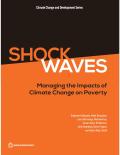
In South-East Asia a number of stakeholders are seeking to leverage green growth strategies, to reach macroeconomic and societal goals, and engage in profitable business. Through experience however, many actors have encountered numerous obstacles and challenges in financing projects, executing transactions and facilitating climate finance flows.
Focusing on financial policy and regulatory developments in Indonesia, Vietnam, the Philippines, Cambodia and Malaysia, this reports explores the different barriers that exist to private climate finance flows in the region. It concludes that capital is hindered from moving towards low-carbon infrastructure because of a number of policy and regulatory barriers, including a lack of policy consistency and alignment, potential liquidity issues in the banking sector, and structural barriers to climate finance innovation in financial markets.
Over the past 30 years, China has developed rapidly to become the world’s second largest economy, reaching the status of a middle-income country. Realizing this success, however, has involved a development approach entailing massive and inefficient resource use, and extensive damage to the quality of air, water and soil. Transforming from a resource- and pollution-intensive economy to a green economy is now a strategic priority for China. Success depends on the development of green industries and the transformation and reduced importance of many traditional industries. Success will be built heavily on green finance, and this is where China is headed.
The aim of this book is to develop specific proposals for greening China’s financial system, based on an analysis of current practice in China and an exchange of experience with international experts. The book proposes a framework for actions covering five key areas that, if adopted by the Chinese government, would promote the systematic development of green finance:
A. Establish and strengthen legal frameworks, including environmental laws and law enforcement that contribute to the demand for green finance.

Climate change and climate policies will affect poverty reduction efforts through direct and immediate impacts on the poor and by affecting factors that condition poverty reduction, such as economic growth. This report explores the relation between climate change, climate policies, and poverty outcomes by examining three questions: the (static) impact on poor people's livelihood and well-being; the impact on the risk for non-poor individuals to fall into poverty; and the impact on the ability of poor people to escape poverty. The report explores various channels through which climate change and policies will affect poverty: economic impacts through incomes and prices; natural disasters and their effects on assets and livelihoods; and health impacts. It also investigates policy options to ensure adaptation and mitigation policies -- such as adaptive and well-targeted social protection, public investments, and financial inclusion policies -- contribute to poverty reduction and protect poor people against climate change impacts.
Eco-innovation globally emerged as an effort to implement sustainable development. States and firms established and implemented policies and strategies for eco-innovation as one route to achieving sustainable development. Eco-innovation has been facilitated in developed countries, specifically OECD members and European countries, through action plans. Recently, eco-innovation policies have emerged in developing countries. Thus, this study analyzes eco-innovation policies in Asian countries. Policies related to eco-innovation in 17 Asian countries were investigated using policy instrument categories. National policies for eco-innovation were interpreted and compared with development stage classifications. The results indicate that there are similar and different policy approaches to eco-innovation in Asian countries. Given the balance between a technology push (supply side) and a market pull (demand side) in policy instruments for eco-innovation, 17 countries were identified by four categories: leaders, followers, loungers, and laggards. The results provide insight for designing national strategies for eco-innovation in Asia’s developing countries.
